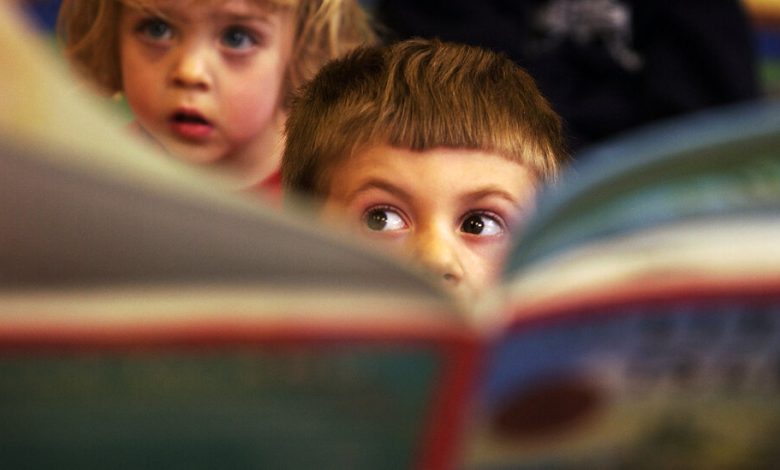What’s the Best Way to Teach Reading?

More from our inbox:
- On Madonna’s New Look: Let’s Celebrate Aging Naturally
- It’s Time to Invest in Working Parents

Credit…Glenn Asakawa/The Denver Post, via Getty Images
To the Editor:
Re “We’re Bad at Teaching Kids to Read,” by Nicholas Kristof (column, Feb. 12):
Mr. Kristof has sadly jumped on the current “phonics” bandwagon. Why do so many teachers resist using a heavy phonics approach? Because English is not a purely phonetic language, and trying to pretend otherwise confuses and frustrates early readers.
Many, many words encountered in simple English text do not follow reliable rules of pronunciation. The words “to” and “do” do not rhyme with “so” or “go.” Nor do “how” and “row” rhyme. And why are “to,” “too” and “two” all pronounced the same?
Programs that heavily emphasize phonics try to create reading materials that mostly exclude nonphonetic words. That sounds logical, but it turns out that nonphonetic words are so ubiquitous in English that sanitized texts are hopelessly artificial.
Please give sensible reading experts a chance to explain why pure phonics is not the answer.
Nick Estes
Albuquerque
To the Editor:
Journalists like Nicholas Kristof and Emily Hanford, whose podcast he writes about, have helped many parents, teachers and teacher educators understand how wrong reading instruction has been for decades.
I was one of those teacher educators preparing teachers using practices popularized by a few passionate leaders whose work had little grounding in the highest quality research. It took a government-formed National Reading Panel to publish its findings in 2000 on effective reading instruction for me to wake up and change my practices.
The report made it unequivocally clear that systematic, explicit phonics is a foundation for teaching children to read. But that report is now decades old, and there is still much work to do.
It’s terrific to see new teacher educators embrace the science, but it may still be years before all teachers are prepared in the ways we know from science will help more children learn to read.
Ellen McIntyre
Knoxville, Tenn.
The writer is the dean of the College of Education, Health, and Human Sciences at the University of Tennessee.
To the Editor:
Experts grapple with phonics and “effective reading instruction,” but the best way to encourage kids to read is to read to them. It’s a win-win when parents, grandparents or caregivers snuggle up with a child and turn the pages of board books or picture books or alphabet books or singalongs at whatever pace the toddler prefers.
“Goodnight Moon,” “Brown Bear, Brown Bear, What Do You See?” and “Chicka Chicka Boom Boom” — I loved reading these classics to my daughters, and I love reading them now to my grandsons.
Librarians can help you pick out ideal age-appropriate books — our tax dollars at work. Going to a baby shower or birthday party? A bookseller can help you select something perfect that will outlast bibs or clothes. Books are gifts that children can open again and again.
In short, if we want our kids to read, let’s read with them, and make it joyful. And let them see you reading too.
Carol Weston
New York
The writer is an advice columnist and an author of books for young people.
To the Editor:
I applaud Nicholas Kristof’s column on the state of reading in our schools today. If your readers would like to know what they can personally do about the situation, I offer a suggestion from personal experience as a retired senior citizen.
Contact your local school district and offer your time to read to children in school. I recently did so and now provide reading assistance to kindergartners three days a week as a volunteer. I work one on one with a child designated by the teacher.
While my suggestion is no panacea, it’s a small step in the right direction.
Charles F. Miller
Bethesda, Md.
On Madonna’s New Look: Let’s Celebrate Aging Naturally
To the Editor:
Re “Madonna’s New Face Is a Brilliant Provocation,” by Jennifer Weiner (Opinion guest essay, Feb. 9):
Ms. Weiner quotes Madonna as saying, “I am happy to do the trailblazing so that all the women behind me can have an easier time in the years to come.” I am curious, how does this represent trailblazing?
Cosmetic surgery for approval or attention, even self-approval, seems less like trailblazing and more like objectification. To see more women aging naturally in the media spotlight would be the definition of a trailblazing and daring example to set.
Suzanne Tenner
Los Angeles
To the Editor:
Jennifer Weiner writes, “I’d like to think that our era’s greatest chameleon, a woman who has always been intentional about her reinvention, was doing something slyer, more subversive, by serving us both a new — if not necessarily improved — face and a side of critique about the work of beauty, the inevitability of aging, and the impossible bind in which older female celebrities find themselves.”
Please. As a 65-year-old woman, I can tell you: Having extreme surgery is certainly not a new way to “critique” the work of beauty, the inevitability of aging, and the impossible bind” in which all older women find themselves.
Thinking about your age, experience, wisdom, big heart, curiosity and the people you love would actually be a good start if you are looking for your beauty.
It strikes me as extremely sad that so many beautiful women in their 40s, 50s and 60s think that erasing their years cosmetically — cutting themselves open, pulling or pushing their skin and rearranging their faces — is a reasonable approach toward getting older.
Until very recently in human history, you were considered lucky to have had the face that you had lived and earned, even with the stuff that you don’t like: the jowls and the wrinkles and the pouches and the bags. I’m trying to live in that place.
Iva Kravitz
Brooklyn
It’s Time to Invest in Working Parents
To the Editor:
Re “As Tech Cuts Back, Layoffs Surprise New Parents” (Business, Feb. 13):
It’s awful that the workers profiled in this article unexpectedly lost gold-standard benefits when their companies cut their jobs.
But this illustrates a much bigger problem: In the United States, unlike in economic peer countries, workers and families are expected to go it alone. They play the lottery when it comes to bosses, child care and wages. Uncertainty characterizes many working families’ experiences.
We need baseline standards and investments: a national paid family and medical leave program similar to programs in 11 states and Washington, D.C., child care investments that reduce families’ costs and increase the quality of child care work, and jobs with fair wages and work schedules.
I feel bad for new parents who have lost high-end jobs and benefits, but I feel worse for people who have never expected or received such benefits and struggle to manage work and family every day because of our country’s individualistic approach to working families. This should be a mobilizing moment for everyone.
Vicki Shabo
Washington
The writer is a senior fellow for paid leave policy and strategy at New America’s Better Life Lab.





